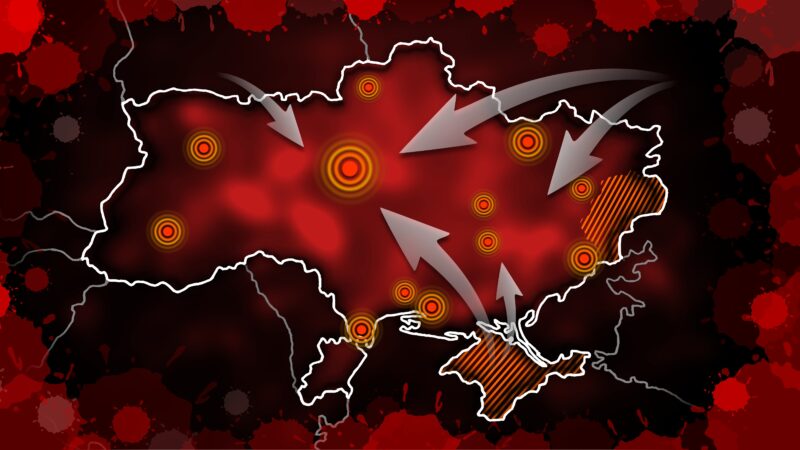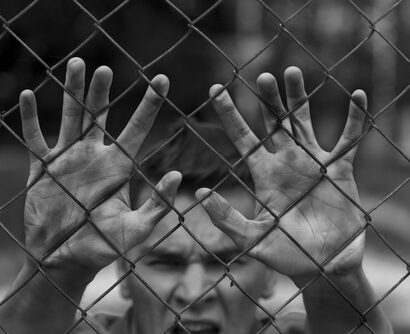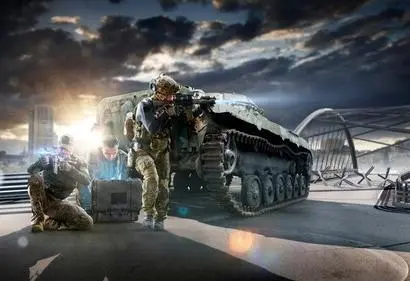Abstract: The Ukrainian Army shot down the Russian paratroopers close to Hostomel and stopped the land march of Russian Land Forces into Kyiv, preventing Russia from striving for regime change. Afterwards, Russia’s “hybrid war” on Ukraine went rogue, creating a 21st-century war, differing widely from forecasts of Western military experts.
Problem statement: How to understand, so far, the interaction of Russia’s hybrid and conventional strategies and tactics in Ukraine, and what are the first implications for the Alliance defence?
So what?: The Russian military forces, Secret Services and PMCs are willing to apply inhumane brutality and violence even in the light of the public. Western assumptions that covert operations, where attribution is almost impossible, would not be conducted by Russia or Russian operatives for morale concerns should be taken off the table.

Source: shutterstock.com/Maclevan
The Hybridity of Russia’s Attack on Ukraine
Although Russia’s attack, called by Russia a “special military operation” only, on Ukraine on February 24, 2022, has to be understood as a hybrid war that went rogue, Russia’s activities after the initial failure in late February 2022 must be also analyzed and addressed as part of conventional war theory rather than part of a “hybrid war” theory only.
Russia’s activities after the initial failure in late February 2022 must be also analyzed and addressed as part of conventional war theory rather than part of a “hybrid war” theory only.
The International Humanitarian law can already be applied to international armed conflicts. However, the Russian Armed Forces and their proxies, like Wagner, have allegedly committed hundreds of war crimes in Ukraine, like targeting killings of civilians, rape, targeting of civilian infrastructure, and the killing of journalists or emergency workers.[1] The operations of the Russian Armed Forces and especially their warfighting tactics have often not even met the most basic international standards set by the Humanitarian Laws of Armed Conflict, which adds an organizational or systemic dimension to the file of the observed war crimes by individual soldiers. Moreover, from a moral perspective, using the suffix hybrid to prevent the sole use of the word “war” would belittle the sacrifices and victims of the Ukrainians.
From Hybrid War to Conventional War
When the initial hybrid-threat approach of using land forces to coerce the Ukrainian government had failed within the first ten days, the Russian Armed Forces regrouped, even by (mis-)using safe Belarussian territory. To the utmost surprise of Western observers, they started to assume an attacking style of World War II-like mass artillery fighting rather than in a 21st-century Western-based modern warfare style based on precision-guided ammunition to reduce civil casualties. This has made the Russian operations rather atrocious and created next to civilian victims also heavy military casualties beneath the Ukrainian Armed Forces.
Next to the brutal and excessive use of military force under the statute of a military strategy called by experts “Terror,” the Center of Excellence Countering Hybrid Warfare Community of Interest for Strategy and Defense also observed open applications of military methods in Ukraine attributed to the arsenal of hybrid warfare in sub-threshold environments: targeting and attacking systemic vulnerabilities to influencing decision-making or undermining and terrorizing the Ukrainian society.
Next to targeting military targets, Russian Forces and their proxies have started to target UKR societal system-relevant targets inside Ukraine. They conducted deliberate and repeated attacks on important railway infrastructures and power grid nodes. These attacks fit the hybrid definition as well as the definition called cross-domain effects in the Western Multi-Domain Operations terminology. In conclusion, Russia has applied an overall system-thinking approach to its warfare capabilities, allowing for more complex military operations.
Next to the brutal and excessive use of military force, the Center of Excellence Countering Hybrid Warfare Community of Interest for Strategy and Defense also observed open applications of military methods in Ukraine attributed to the arsenal of hybrid warfare in sub-threshold environments.
Whereas the Ukrainians were able to show a very resilient railway system,[2] the UKR power system, assumingly due to the size and need of essential infrastructures and critical spare parts, has regularly suffered heavily from missile strikes with longer-lasting power outages.
Furthermore, Russian military targeting in Ukraine has – against all international standards and agreements – indiscriminately acted against military and civilian targets. In particular, they applied a ruthless “double tap targeting” of civilian targets by attacking civilian compounds twice with a time delay to hit emergency and rescue personnel trying to rescue victims from the first attack to create fear inside the population. This military strategy built on pure “terror” has been applied by Russian forces earlier, e.g. in Syria.[3]
Russian disinformation experts have tried to influence the Ukrainian population through “targeted messaging” over the years. However, their efforts fell flat in light of the war crimes committed by Russian troops, e.g., in Butcha. Nevertheless, Russian propaganda addressing the “evil Ukrainians”, has been continuously successful among the Russian population. Internet polls still show a total lack of Russian empathy or sympathy for Ukrainians.[4]
Also, the role and use of Private Military Contractors have changed. Wagner et al. became an integrated part of military operations at the frontline. This has been an unusual move. PMCs are usually not part of military operations because they cannot – for disciplinary and or fiscal ownership reasons – be effectively and persistently integrated into military command and control structures. However, these new “battlefield necessities” “for Wagner at the front” seem to have been created due to the – for the Russian Army seemingly unexpected – strong resistance of the Ukrainians at the beginning of the attack: Russian Army Units suffered from the beginning heavy personnel losses which can be directly linked to their Battalion Task Group (BTG) concept:
Two BTGs are created out of one Army brigade and consist mainly of professional soldiers, so-called military core personnel. When those units started to receive heavy losses, it reduced their ability to train the incoming draftees from the mobilization, resulting in less and badly trained new soldiers.
This results in PMC–veterans or former criminals, motivated by money or a pardon from their crimes only, filling forward positions at the front. But their trustworthiness might be seen sceptically, an assumption being proved by the assumed Prigoshin failed coup d’état over the end of June.[5]
PMCs are usually not part of military operations because they cannot – for disciplinary and or fiscal ownership reasons – be effectively and persistently integrated into military command and control structures.
Although many Western observers were surprised by how Russia conducts its military operations, all these examples are deeply linked and rooted in their theoretical military and strategic thinking. However, for the first time, the Russian idea of reflexive control theory is similarly and parallel applied in sub-threshold hybrid warfare environments and real war environments simultaneously; whether by accident or purpose, will be seen after the war.
Reflexive Control
“Reflexive control is an activity which influences the adversary’s decision-making processes with a specifically altered piece of information in a prepared information campaign. The primary goal of such doctored information is to induce the other side to make decisions that are, in fact, predetermined by the producer of the doctored information.”[6]
Reflexive control is an activity which influences the adversary’s decision-making processes with a specifically altered piece of information in a prepared information campaign.
The concept of reflexive control has a long history in Russian military strategy. Taught in military schools and academies, it is also codified in the Russian National Security Strategy. Its elements include:
- Power pressure (provocation and deterrence);
- Measures to present false information about the situation (deception, distraction and paralysis);
- Influencing the enemy’s decision-making algorithm (exhaustion, divisions and suggestion); and
- Altering the decision-making time (pacification and overload).[7]
The foundations of Russian Reflexive control reach back more than 200 years. It follows the ideas of General Peter Rumyantsev (thought) and Alexander Suvorov (science of victory).[8] Overall, reflexive control loosely follows the concept of one Chinese General Sun Tzu’ commandments of war: “The supreme art of war is to subdue the enemy without fighting”. It was updated in the late 20th century by Evgeny Messner with his ideas on subversion war – an activity that is intended to erode an adversary’s socio-cultural and military cohesion – , Alexander Dugin’s network-centric war – rather in a virtual dimension, establishing control over networks, more political than military, not to be mixed up with western ideas of Network Centric Warfare – , as well as Igor Panarin’s Information warfare, coping with psychological and specifically informational aspects. All information means are used to target decision-making processes by manipulating international and domestic public opinion.[9]
The Use of Modern Technologies with Hybrid Character
From the beginning of humankind, war has been a relentless innovator, and Russia’s war against Ukraine makes no exemption to this rule.
Uninhabited Aerial Vehicles
Using low-cost drones at scale, first seen in the war between Azerbaijan and Armenia in 2021, has modified land warfighting tactics on both sides. It has added a third dimension to infantry fighting, but also a new cognitive effect – the use of thermal or infrared imaging on drones reduced the ability of soldiers to move in the field drastically up to the moment that the single soldier cannot move at all due to a permanent UAV threat, which seems to be psychologically amplified by the high pitch of the drone engines, creating a so far unknown feeling of isolation and fear for soldiers on the battlefield. These psychological effects should also be considered when protecting Western critical infrastructure.
Software Innovation
Whereas the Russians missed so far in installing a “battlefield wide tactical network” to integrate UAV, Ukrainians adapted the “Uber Software to track Uber cars”, to create a very agile cross-services IT-based targeting system, which allowed them to conduct joint fires on the lowest tactical level even using tanks as high precise artillery guns.
Cyber
Ukrainian IT systems are under permanent Russian attacks. Cyber-attacks will not cease during a conventional war. On the other hand, so-called spill-over or domino effects of offensive cyber operations – as forecasted by Western experts as an argument against the use of offensive military cyber operations – are, so far, not being observed. Finally, critical infrastructures must be identified early, protected, and defended in the physical and cyber domains simultaneously.
Ukrainian IT systems are under permanent Russian attacks. Cyber-attacks will not cease during a conventional war.
Hybrid Threats and Warfare Around Ukraine
Heavy Russian hybrid activities accompany the war in Ukraine. Russia applies almost all of the above means and methods in other operations around the world:
- Russian Private Military Companies (PMCs) acted in Africa as brutally as in Ukraine, but almost without any international reaction. The killing of 300 Malian civilians by Wagner mercenaries and Mali Army units created almost no international reaction;[10]
- Permanent Russian disinformation campaigns through pre-established networks all over Europe and the Americas;
- The use of so-called “useful idiots” and influencers in almost all Western societies;
- Unattributed or denied attacks on pipelines and critical infrastructures all over Europe; and
- Cyber attacks on Western political leaders, especially those who have committed themselves publicly against Russia.
What Will Russian War and Warfare Provide for Hybrid Warfare and Hybrid Threats
Next to the courage and bravery of the Ukrainian forces fighting highly innovative, the Russians demonstrated highly incompetent strategic and tactical behaviour several times. Nevertheless, one should not underestimate the Russian forces – after strategic misconceptions at the beginning of the war, formations were successfully reorganized, withdrawn and regrouped via (a safe) Belarus just to reattack via the Eastern parts of Ukraine, accompanied by the formal political annexation of Donbas and Luhansk.
The Russian military forces, Secret Services and PMCs are willing to apply inhumane brutality and violence even in light of the public. Western assumptions that covert operations, where attribution is almost impossible, would not be conducted by Russia or Russian operatives for morale concerns should be taken off the table.
Whether Western militaries like NATO Allies can create with its ongoing and floating ideas of a “Cognitive warfare concept”, a concept able to cope with Russia’s reflexive control theory, is seen by the author as sceptical. By copying it, it will be a value-based-subset only, which can’t create the Russian’s outreach. Additionally, Russia has implemented system-thinking in hybrid as well as conventional military thinking, and it is conducting military operations and targeting accordingly.
Russia has implemented system-thinking in hybrid as well as conventional military thinking, and it is conducting military operations and targeting accordingly.
This fosters the need for a fast implementation of Multi-Domain Operations and re-thinking defence as a total defence by integrating non-military security providers and striving for societal resilience.
Over the last year, pundits have permanently analyzed and discussed possible scenarios for the outcome of Russia’s war on Ukraine. One of the constants in all scenarios was that hybrid threats and warfare would continue due to their cheap and, unfortunately, effective and flexible nature. The unexpected high conventional losses of personnel and material of the Russian military amplify the risks of hybrid threats in a post-war setting. Whether Russia will win or lose the war, to bridge the time gap of regaining sufficient conventional military power, hybrid threats and warfare will be Russia’s first and cheapest choice to control, especially in the European geopolitical sphere.
Sönke Marahrens, Colonel i.G., Dipl. Inform (univ), MPA, Director of Communty of Interest for Strategy and Defense at the European Center of Excellence for Countering Hybrid Threats in Helsinki, Finland. Research interests: Strategy and Armed Forces, Cyber, AI, War in the 21st Century, Wargaming, The Prussian War Game. The views contained in this article are the author’s alone and do not represent the views of the HybridCoE or the German Federal Armed Forces.
[1] Lonas Lexy, “Here are Russia’s alleged war crimes in the Ukraine invasion,” The Hill, https://thehill.com/policy/international/3262626-here-are-russias-alleged-was-crimes-in-the-ukraine-invasion/.
[2]Jack Peat, “War-torn Ukraine running more reliable train service than TransPennine Express,” January 06, 2023, https://www.thelondoneconomic.com/news/war-torn-ukraine-running-more-reliable-train-service-than-transpennine-express-342002/.
[3] Claire Parker, “Russia and Syria conducted dozens of illegal ‘double tap’ strikes, report says,“ The Washington Post, https://www.washingtonpost.com/world/2022/07/21/syria-russia-double-tap-airstrikes-report-war-crimes/.
[4] Lew Gudkov, “Interview Conducted by Christina Hebel in Moscow,” Der Spiegel, https://www.spiegel.de/international/world/opinion-researcher-lev-gudkov-russians-have-little-compassion-for-the-ukrainians-a-066c08c6-60f4-48e1-853a-d2b3d67bd6b8.
[5] The initial assumption about the trustworthiness of the mercenaries was already raised during the Webinar on 14.02.2023.
[6] ”Seeing Red,” Hybrid COE 8th Research Report, Jukka Aukia & Lucjan Kubica, March 2023, 34.
[7] Former Research Director of Hybrid COE, Prof Dr Hanna Smith, in a “mind-opening” email exchange with the author.
[8] Idem.
[9] Idem.
[10] Emmanuel Akinwotu, April 05, 2022, “Russian mercenaries and Mali army accused of killing 300 civilians,” https://www.theguardian.com/world/2022/apr/05/russian-mercenaries-and-mali-army-accused-of-killing-300-civilians.






